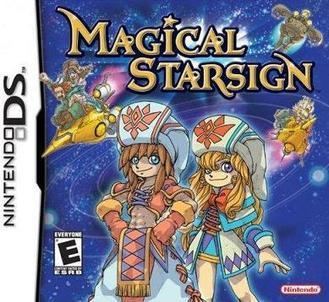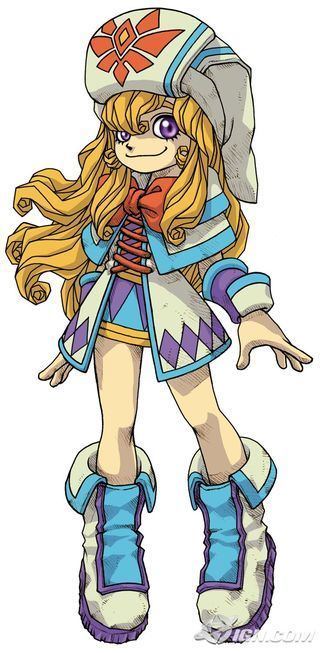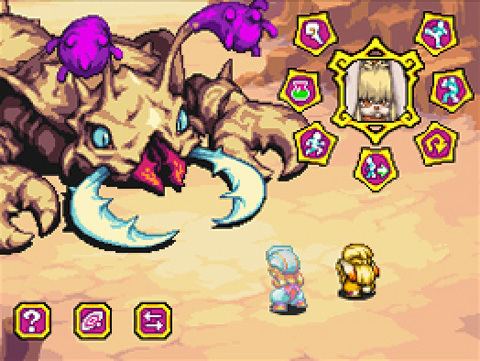7.2 /10 1 Votes7.2
69% Metacritic Artist(s) Shinichi Kameoka Series Magical Starsign Developer 1-UP Studio | 7.5/10 IGN 69% GameFAQs Composer(s) Tsukasa Masuko Initial release date 22 June 2006 | |||||||||||||||||||||||||||||||||
 | ||||||||||||||||||||||||||||||||||
Mode(s) Single Player, Multiplayer (up to 6 players on Local Wireless) Similar 1-UP Studio games, Role-playing video games | ||||||||||||||||||||||||||||||||||
Magical starsign trailer
Magical Starsign, originally released in Japan as Magical Vacation: Itsutsu no Hoshi ga Narabu Toki (マジカルバケーション 5つの星がならぶとき), is a role-playing video game for the Nintendo DS developed by Brownie Brown. It is the sequel to the Japan-exclusive Game Boy Advance title, Magical Vacation. Magical Starsign is the second game in the Magical Starsign series and was released in Japan and the United States in 2006 and was released in Europe the next year. Nintendo Australia has said that it would not publish the game in the Oceanic region as it expected low sales of the game.
Contents
- Magical starsign trailer
- Let s play magical starsign 01 welcome to will o wisp academy
- Gameplay
- Astrolog
- Multiplayer
- Plot
- Setting
- Classmates
- Faculty
- Pirates of Cassia
- Space Police
- Localization
- Reception
- References

Let s play magical starsign 01 welcome to will o wisp academy
Gameplay

The player uses the Nintendo DS's touch screen for character control and interaction, while the top screen displays maps and other general information. The battle system is turn-based, and the position of the planets within the game affects the amount of damage wielded or received by each character. All characters in the game are associated with a specific planet, and their magic attack power is boosted when a character's planet is positioned favorably. Players can also boost their attack power by tapping their character when the circle of symbols has disappeared around them during a battle. This is known as a "Spell Strike", and a large flash of color (the same color assigned to the character's element) appears prior to the attack. The player may also tap their character right before they are hit with an attack to receive less damage. This is known as a "Reflex Guard," and puts the character into a guard stance and causes them to glow with blue light. However, some attacks cannot be guarded against in this way.
Astrolog
There are 7 different elements in the game (light, darkness, fire, water, wood, earth, and wind) which each correspond to a planet in the game's solar system. The Astrolog tracks the movement of these planets, which move clockwise around a central point as time passes within the game. The orbital velocity of each planet varies according to their size and location. Magic spells of certain elements are twice as effective while a planet is orbiting within the area assigned to its corresponding element. This bonus applies for both the player's magic spells and enemy spells. The light and dark elements are instead affected by solar activity: light magic is more powerful during the daytime, and dark magic is more powerful during the night (in-game time is viewable as an animated hourglass). A certain spell acquired later in the game allows the player to move the planets to an advantageous position; or potentially align the 5 planets in a straight line (as indicated in the Japanese version's subtitle), which causes far more damage than the standard elemental bonus. The planets may also happen to align without using the spell, but this causes damage to both the player and the enemy.
Multiplayer
Up to six players may connect locally (a game card is required for each player), taking their characters into a dungeon where they work together to defeat monsters while racing to collect treasure. Points are awarded for damage done to enemies and treasure collected from chests, and the player with the most points at the end wins the multiplayer mode. Experience points and treasures gained in this mode are applied to the main game.
Tag mode allows players to exchange game data to gain new items. Up to 100 players are recorded on the game's friend list, and the item gained will vary depending on in-game progress or the main character's element. There is also an option to create a short message displayed when tag mode is used, allowing players to exchange messages with each other. Using the tag mode frequently will create an "egg character," which becomes stronger each time tag mode is used successfully. The player can use the egg character in the main game, but it will not gain levels with experience like other characters.
Plot
The solar system of Magical Starsign consists of 6 planets: the planets of fire, wood, wind, water, earth, and another small planet on the fringes of the solar system called Kovomaka. Kovomaka houses the Will-O-Wisp academy of magic, where 6 aspiring magicians are studying in the same class under the guidance of their teacher, Miss Madeline. One day, Principal Biscotti receives word that Master Kale, a graduate of the academy, has become the leader of the space pirates, and is planning to destroy the solar system. He sends Miss Madeline out into space on a mission to prevent Master Kale from achieving his evil plans, but loses all contact with her shortly afterwards. 3 months later, Lassi, one of the current students in the academy, discovers a small spaceship hidden on the roof of the academy building, and goes off into space in search of Miss Madeline. The hero of the story pursues Lassi in another spaceship, but is forced to crash land on another planet. The player must reunite with the other 5 classmates, rescue Miss Madeline, and derail Master Kale's evil plans in a wild journey across outer-space.
Setting
The story takes place within the seven planets of the Baklava solar system. Transportation between planets is made possible by using a magical spaceship, and players may freely visit other planets as the story progresses. The planets also play an important role in the game's battle system.
The first planet, Kovomaka, is an obscure magic planet located on the fringe of the solar system, which houses the Will-O-Wisp academy of magic. It is not listed on Astrologs because of its small size and location, and the people living on the planet are unaware of the presence of other planets, as other planets are unaware of Kovomaka's existence for the same reason.
Erd (Hikarabita (ヒカラビータ, hikarabīta) in the Japanese version) is the earth planet, where the player makes a crash landing at the beginning of the game. The planet is covered with stone mountains and desert, and is mostly populated by ancient robots and spiny mole people. Ancient ruins are located all across the planet. The ancient Espresso people lived on this planet before becoming extinct by "gummification" to power the robot power cells. There were also nine Stone Giants who once roamed the planet, the last one being Tektos, who was killed in an attack against Magnus Muzzleflash and gave the Earth Millennium Gummy to the children as a parting gift.
Cassia (Rig Maha (リグ・マハ, rigu maha)) is the water planet, which consists of two large islands. The planet is mainly populated by otter people, and another magic academy, Ambergis Prep, established prior to Will-O-Wisp is located on Granule Island. Cassia is frozen cold when the player first arrives. The planet is home to the Aquarino, a water particle that neither freezes or evaporates as a side effect of being set on fire by the "Fire Otter". The planet is also home to the Holy Water Pyramid, home to the Water Millennium Gummy and the ancient race of water people.
Puffoon (Cotton (コットン, kotton)) is the wind planet, where the headquarters of the Space Police are located. This was the player's intended destination prior to the crash-landing, and endless barren land stretches out beyond highly developed cities, leading to various odd areas such as the rabbit-populated town of Honey Mint White Caramel Fudgeflake with Melty Butter and Syrup and Whipped Cream on Top and the Couscous Ruins, a strange area home to the Wind Millennium Gummy where "time just piles up like snow".
Gren (Kaopiter (カオピター, kaopitā)) is the wood planet, which is mostly covered with jungle terrain. The planet is populated with Felin and Salamander people, and the space pirate base is also located here. The giant tree Yggsalad soars above the deepest parts of the jungle. The salamanders used to live in Yggsalad, but the pirates evicted them five years ago. The heroes obtained the Wood Millennium Gummy here, after a Felin named Semolina sacrificed herself to the anthropophagus, a man-eating flower within Yggsalad. The planet was at one point set on fire.
Razen (Raguafor (ラグアフォー, raguafō)) is the fire planet, which cannot be entered by normal spaceships because of its extreme heat. Rivers of lava flow on the planet's surface, and the central mountain houses many dwarves. A stone stage deep in the cave called World's Seam acts as a portal to Nova. Another cave, called Capscium Caverns is home to a (nonexistent) dragon called Scargot and the Fire Millennium Gummy. Two different species live here, living pots and dwarves. Dragons used to live on the planets (as evidenced by skeletons in Capscium Caverns), but became extinct due to unknown reasons (a dwarf believes Scargot killed them all, suggesting that at one point Scargot was an actual dragon.)
Nova is the light planet and one of two planets within the Baklava system's sun. It is populated by odd creatures called Dancing Fruit and the people of the light, the Luminites, whose queen dies and lives under mysterious circumstances. The Luminite palace holds a Starway to the other planet in the sun, Shadra. A dungeon called Glissini Caves lies hidden under the planet's surface, holding a powerful version of Shadra called Umbra.
Shadra is the dark planet and one of two planets within the sun. The mountainous planet is populated by enigmas, physical embodiments of darkness, varieties including Piskpooka, Dab Hasnel, and Equillekrew (all featured in Magical Vacation). A massive worm, Shadra, that is destined to eat the sun lives in massive caverns called Chromagar Caves, which turns any living thing that lingers there into a gummy to be eaten by Shadra.
Classmates
Faculty
4 other characters from the game's prequel, Magical Vacation, are mentioned throughout the story but do not make actual appearances in the game. Pistachio Maplewood (ピスタチオ・メイプルウッド) is mentioned as a teacher at the Will-O-Wisp academy who is unpopular with students because of his strict teaching style. Ganache Nighthawk (ガナッシュ・ナイトホーク), Vanilla Nighthawk (ヴァニラ・ナイトホーク), and Blueberry Lakeside (ブルーベリー・レイクサイド) are also referred to at various points in the story..
Pirates of Cassia
The space pirates are a group of villains that have recently started to abduct magicians. Their main base is located on the wood planet, Gren, and most of them are otters who wield the water element. Low-ranking members tend to attack with swords, fishing rods, or ship anchors instead of magic.
Space Police
The space police base is located in the wind planet, Puffoon, and they are notorious for redirecting cases to other departments or ignoring them completely. They are secretly in league with the Pirates of Cassia, and generic police officers fight using light magic, bombs, and martial arts. They also have special shields made by the dwarves equipped on their backs, which allow them to fly.
Localization
Like many Japanese games released in other countries, most of the character names and place names of Magical Starsign underwent changes during localization. Characters are named after foods or drinks in both the Japanese and English versions, and each species has its own theme of food for their names. For instance, the mole people encountered on Erd are all named after various cheeses (Bleu, Munster, Cheddar), while dwarves are named after sauces, dressings, and other condiments.
Reception
Critical reception for Magical Starsign was positive on the whole, with the game scoring an average of 71% on GameRankings. IGN awarded the game 7.5/10, stating "anyone looking for a true classic RPG should look no further". Eurogamer scored the game 8/10, calling it "something which is well worth a look for any RPG fan who's in the market for a handheld adventure". Press Start Online said that the game "updates the 2D turn-based RPG in a way that fans of the genre will find irresistible". And in Japan, Famitsu magazine scored the game a 31 out of 40.
